Buffer Tank Discharge Strategies in the Case of a Centrifugal Water Chiller
Abstract
:1. Introduction
2. Materials and Methods
- Cooling energy is provided by the centrifugal water chiller (scenario 1);
- The cooling energy is provided by the centrifugal chiller, using the cooling buffer tank:
- 0:00–5:00 charging; discharging when tmean;w.tank < treq.sup.c.w. (scenario 2);
- 0:00–5:00 charging, discharging just after 12:00 when tmean;w.tank < treq.sup.c.w. (scenario 3).
- Free cooling mode;
- Comfort mode:
- Based on CO2 signal (<1000 PPM);
- Based on 100% fresh air.
3. Results and Discussion
4. Conclusions
- The use of a buffer tank can achieve notably seasonal efficiency improvements for water chillers with centrifugal compressors (in the case examined, between 27.4% and 30.3%);
- By using a buffer tank, the energy demand of the cooling system can be significantly reduced (in the case examined, between 14.6% and 15.0%);
- By using a buffer tank, the seasonal operating time of the water chiller can be remarkably reduced (in our case: between 13.8% and 29.9%);
- For scenario 3, after the first third of the cooling period, less energy is consumed compared to scenario 2;
- The utilization of the buffer tank is severely limited by the design of the heat exchangers for low supply water temperatures, so operation from the buffer tank is not possible during peak heat load periods;
- By re-sizing the cooling heat exchangers (at least 12 °C supply water temperature), the utilization of the buffer tank can be improved.
Author Contributions
Funding
Data Availability Statement
Conflicts of Interest
Appendix A
| Thermal calculations | MSZ-04-140-2:1991 |
| MSZ-04-140-3:1991 | |
| MSZ-04-140-4:1978 | |
| MSZ EN ISO 13370:2017 | |
| MSZ EN 12831:2017 | |
| Thermal and moisture properties of building materials and products | MSZ EN ISO 10456:2008 |
| Thermal bridge calculations | MSZ EN ISO 6946:2017 |
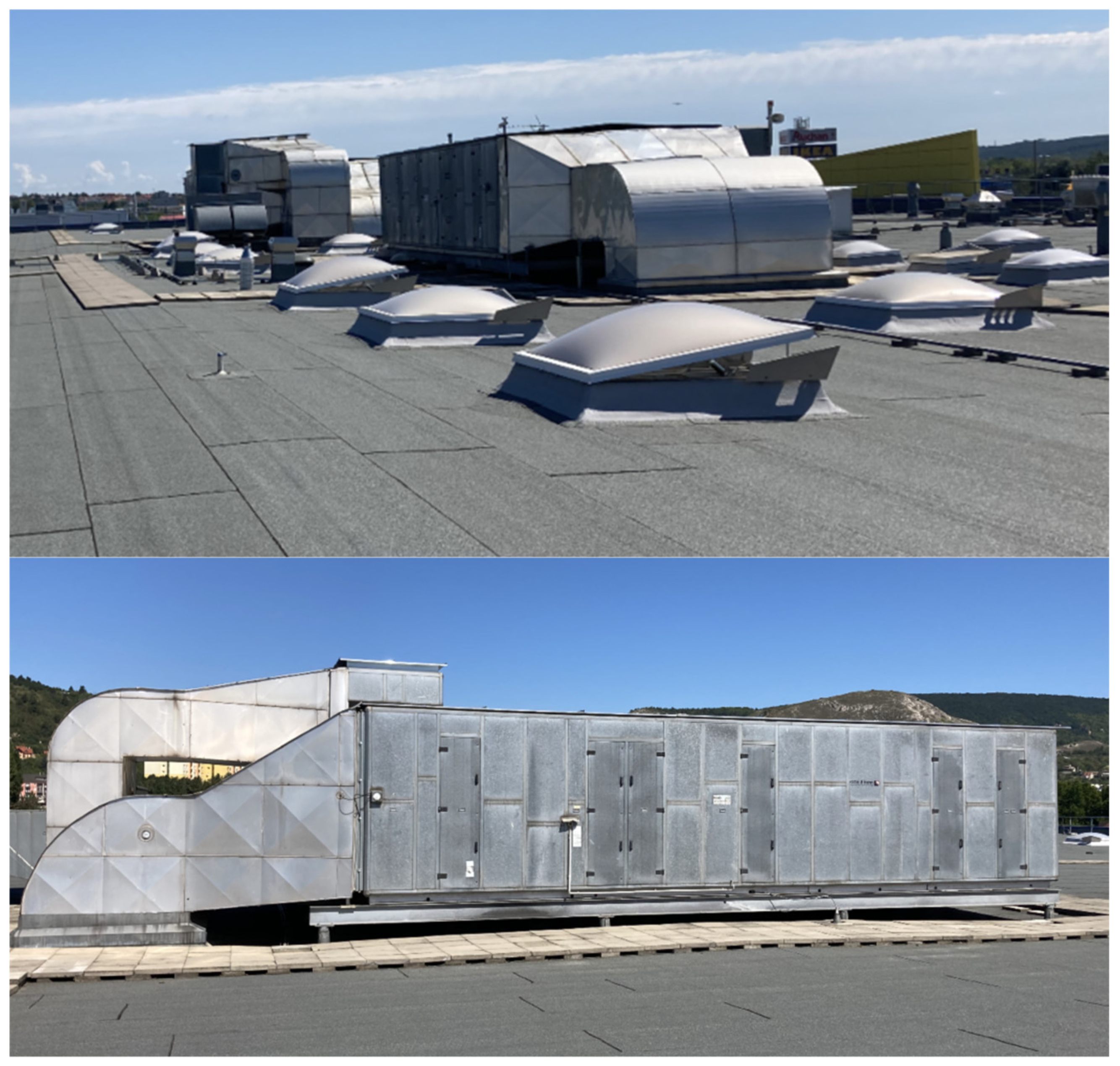


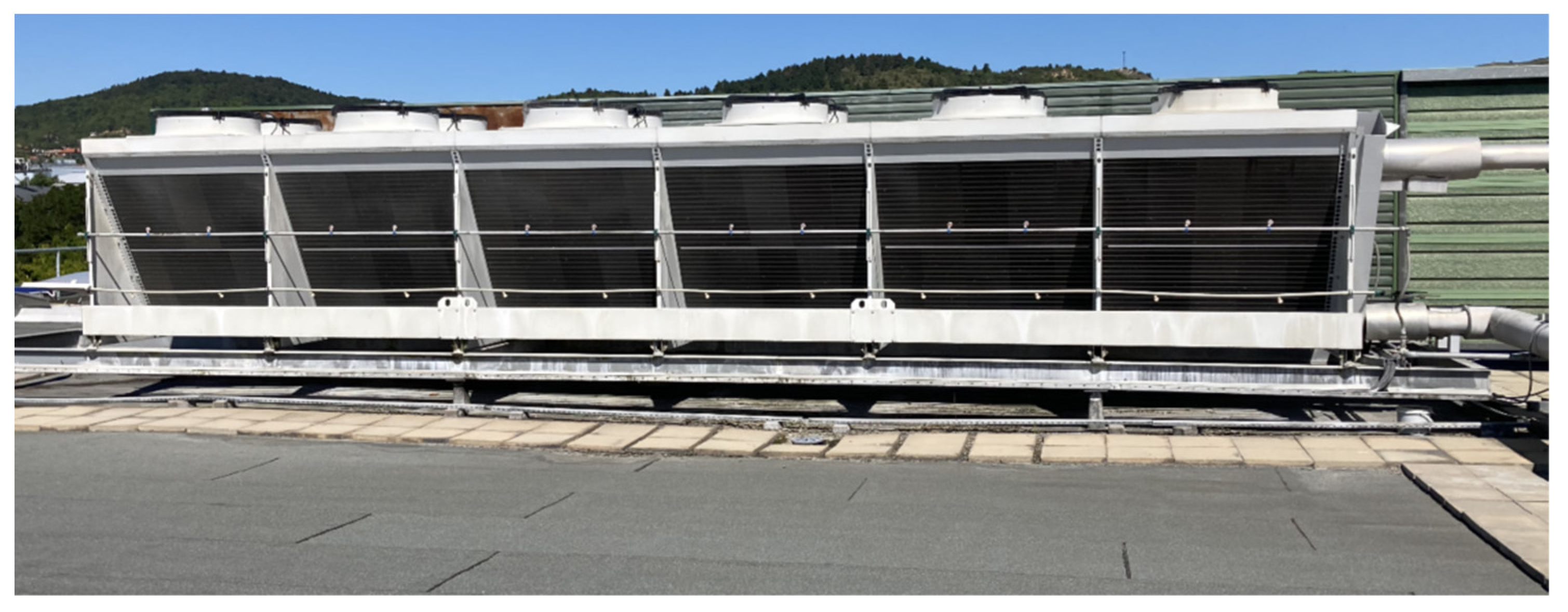
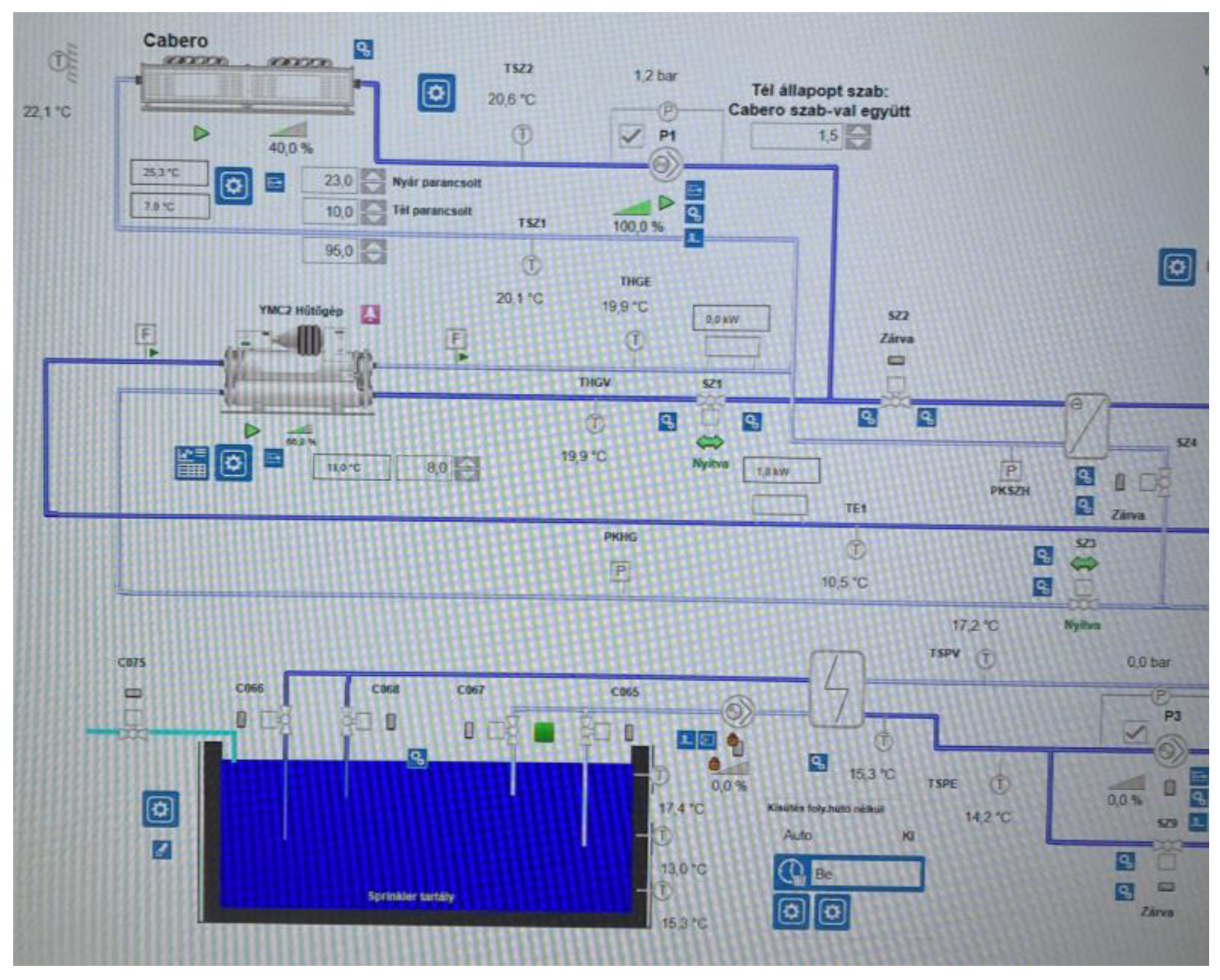
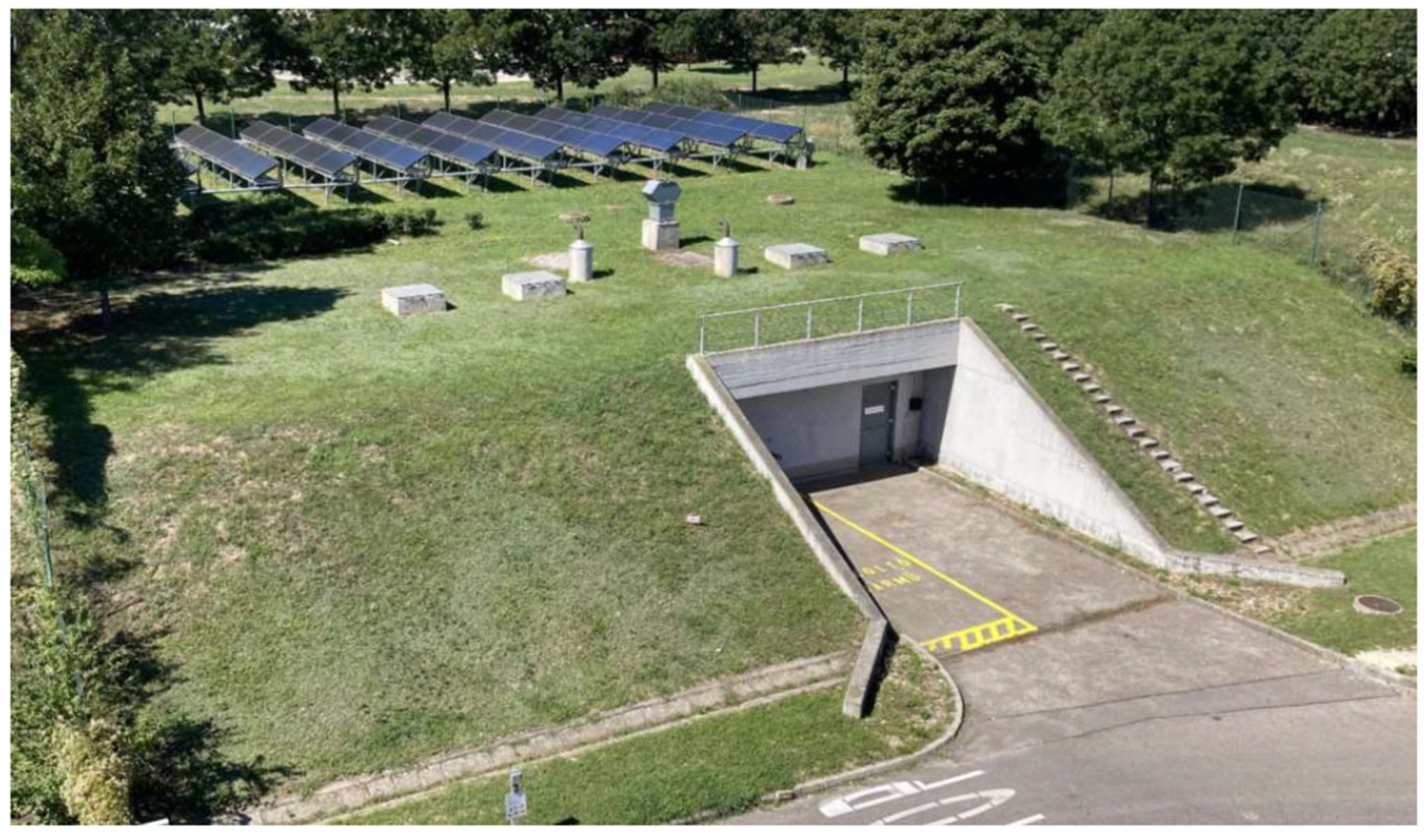
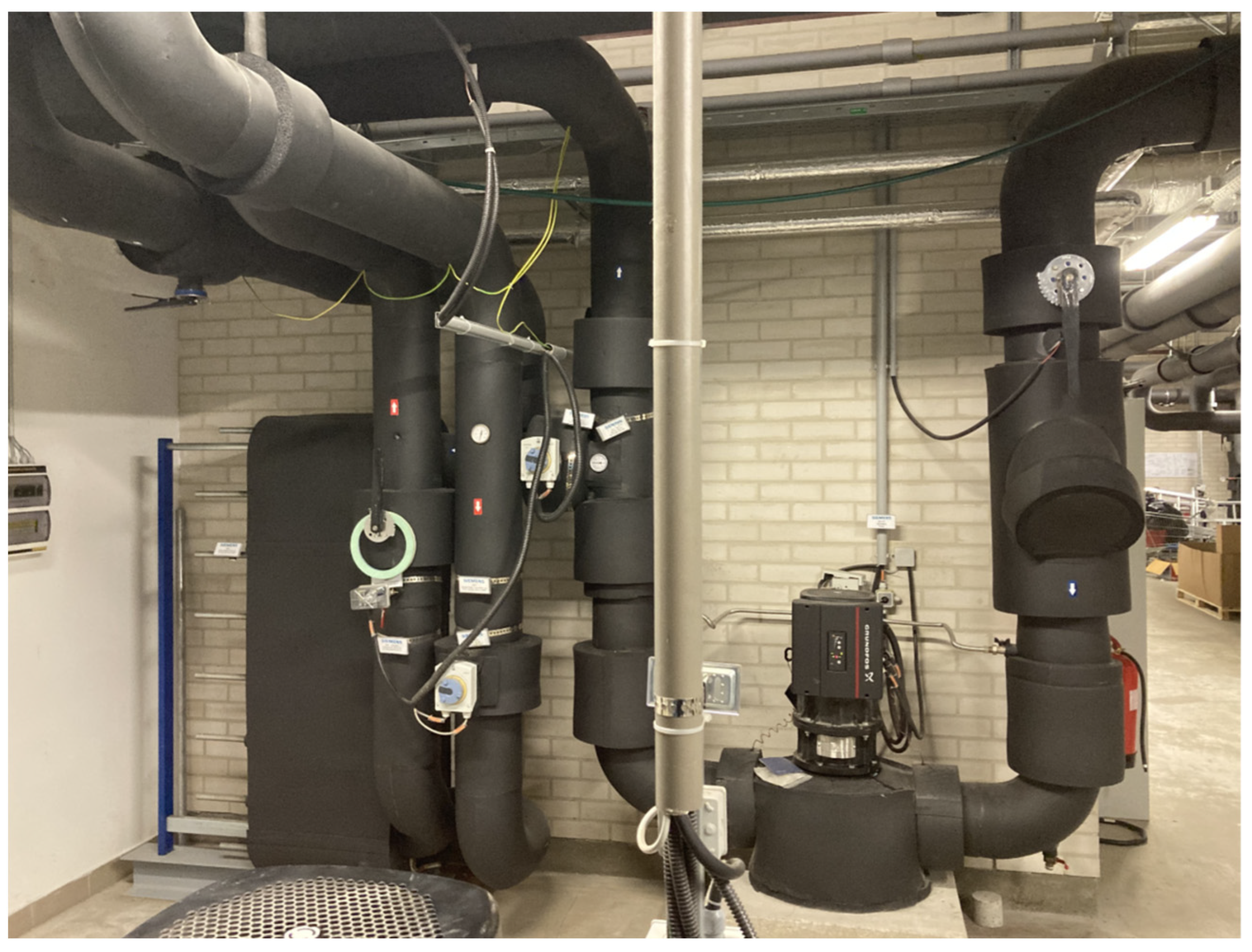
References
- Antoniadou, P.; Papadopoulos, A.M. Occupants’ thermal comfort: State of the art and the prospects of personalized assessment in office buildings. Energy Build. 2017, 153, 136–149. [Google Scholar] [CrossRef]
- EU Parliament. EU of the European Parliament and of the Council; Directive 2010/31; EU Parliament: Strasbourg, France, 2010.
- Average Monthly Electricity Wholesale Prices in Selected Countries in the European Union (EU) from January 2020 to October 2022. Available online: https://www.statista.com/statistics/1267500/eu-monthly-wholesale-electricity-price-country/ (accessed on 18 October 2022).
- Mui, K.W.; Satheesan, M.K.; Wong, L.T. Building Cooling Energy Consumption Prediction with a Hybrid Simulation Approach: Generalization beyond the Training Range. Energy Build. 2022, 276, 112502. [Google Scholar] [CrossRef]
- Kalmár, F.; Kalmár, T. Interrelation between mean radiant temperature and room geometry. Energy Build. 2012, 55, 414–421. [Google Scholar] [CrossRef]
- Wang, X.; Chen, D.; Ren, Z. Assessment of climate change impact on residential building heating and cooling energy requirement in Australia. Build. Environ. 2010, 45, 1663–1682. [Google Scholar] [CrossRef]
- Huang, K.-T.; Hwang, R.-L. Future trends of residential building cooling energy and passive adaptation measures to counteract climate change: The case of Taiwan. Appl. Energy 2016, 184, 1230–1240. [Google Scholar] [CrossRef]
- The European Parliament and the Council of the European Union. Directive 2012/27/EU of the European Parliament and of the Council of 25 October 2012 on energy efficiency, amending Directives 2009/125/EC and European Union. Off. J. Eur. Union 2012, 315, 1–56. [Google Scholar]
- Ahmad, T.; Chen, H.; Guo, Y.; Wang, J. A comprehensive overview on the data-driven and large scale based approaches for forecasting of building energy demand: A review. Energy Build. 2018, 165, 301–320. [Google Scholar] [CrossRef]
- Szodrai, F.; Lakatos, Á.; Kalmár, F. Analysis of the change of the specific heat loss coefficient of buildings resulted by the variation of the geometry and the moisture load. Energy 2016, 115, 820–829. [Google Scholar] [CrossRef] [Green Version]
- Cabeza, L.F.; Castell, A.; Medrano, M.; Martorell, I.; Pérez, G.; Fernandez, A.I. Experimental study on the performance of insulation materials in Mediterranean construction. Energy Build. 2010, 42, 630–636. [Google Scholar] [CrossRef]
- Tiwari, G.; Mishra, R.; Solanki, S. Photovoltaic modules and their applications: A review on thermal modelling. Appl. Energy 2011, 88, 2287–2304. [Google Scholar] [CrossRef]
- Djuric, N.; Novakovic, V. Review of possibilities and necessities for building lifetime commissioning. Renew. Sustain. Energy Rev. 2009, 13, 486–492. [Google Scholar] [CrossRef]
- CRobinson, C.; Dilkina, B.; Hubbs, J.; Zhang, W.; Guhathakurta, S.; Brown, M.A.; Pendyala, R.M. Machine learning approaches for estimating commercial building energy consumption. Appl. Energy 2017, 208, 889–904. [Google Scholar] [CrossRef]
- Amasyali, K.; El-Gohary, N.M. A review of data-driven building energy consumption prediction studies. Renew. Sustain. Energy Rev. 2018, 81, 1192–1205. [Google Scholar] [CrossRef]
- Zhao, H.-X.; Magoulès, F. A review on the prediction of building energy consumption. Renew. Sustain. Energy Rev. 2012, 16, 3586–3592. [Google Scholar] [CrossRef]
- Kumar, R.; Aggarwal, R.; Sharma, J. Energy analysis of a building using artificial neural network: A review. Energy Build. 2013, 65, 352–358. [Google Scholar] [CrossRef]
- Fumo, N. A review on the basics of building energy estimation. Renew. Sustain. Energy Rev. 2014, 31, 53–60. [Google Scholar] [CrossRef]
- Ngo, N.-T.; Pham, A.-D.; Truong, T.T.H.; Truong, N.-S.; Huynh, N.-T.; Pham, T.M. An Ensemble Machine Learning Model for Enhancing the Prediction Accuracy of Energy Consumption in Buildings. Arab. J. Sci. Eng. 2022, 47, 4105–4117. [Google Scholar] [CrossRef]
- YMC2 Magnetic Bearing Centrifugal Chiller. Available online: https://www.york.com/commercial-equipment/chilled-water-systems/water-cooled-chillers/ymc2_ch/ymc-magnetic-bearing-centrifugal-chiller (accessed on 20 October 2022).
- Renedo, C.; Ortiz, A.; Pérez, S.; Delgado, F.; Fernández, I.; Carcedo, J. Improving the efficiency of an air conditioning system using a fire water tank as thermal accumulator. Build. Serv. Eng. Res. Technol. 2015, 36, 386–405. [Google Scholar] [CrossRef] [Green Version]
- Baur, J.M. Simulation of Energy Storage Tanks with Surface Heat Exchangers. Ph.D. Thesis, University of Wisconsin Madison, Madison, WI, USA, 1992. [Google Scholar]
- Lissandrin, M.; Rampazzo, M.; Cecchinato, L.; Beghi, A. Optimal operational efficiency of chillers using oil-free centrifugal compressors. Int. J. Refrig. 2017, 82, 83–96. [Google Scholar] [CrossRef]
- Wang, Z.; Zhong, J.; Pan, Z. Research of cooling load & chiller selection in metro station. Int. J. Low-Carbon Technol. 2020, 15, 506–512. [Google Scholar] [CrossRef]
- MSZ EN 832:2002. Thermal Performance of Buildings. Hungarian Standard Commitment: Budapest, Hungary, 2002.
- Rasouli, M.; Akbari, S.; Simonson, C.J.; Besant, R.W. Energetic, economic and environmental analysis of a health-care facility HVAC system equipped with a run-around membrane energy exchanger. Energy Build. 2014, 69, 112–121. [Google Scholar] [CrossRef]
- Kassai, M. Prediction of the HVAC Energy Demand and Consumption of a Single Family House with Different Calculation Methods. Energy Procedia 2017, 112, 585–594. [Google Scholar] [CrossRef]
- Nyers, A.; Pek, Z.; Nyers, J. Dynamical behavior of a heat pump coaxial evaporator considering the phase border’s impact on convergence. Facta Univ. Series: Mech. Eng. 2018, 16, 249–259. [Google Scholar] [CrossRef]
- Bodo, B.; Kalmár, F. Analysis of primary energy use of typical buildings in Hungary. Environ. Eng. Manag. J. 2014, 13, 2725–2731. [Google Scholar] [CrossRef]
- Bausoft. WinWatt Summer Heat Load Calculation. Available online: http://www.bausoft.hu/ww_nyari_en.htm (accessed on 7 December 2022).
- MSZ CR 1752:2000. Ventilation for Buildings. Hungarian Standard Commitment: Budapest, Hungary, 2000.
- Szabó, G.L. Exergetic optimization of absorption chillers—A case study. Case Stud. Therm. Eng. 2021, 28, 101634. [Google Scholar] [CrossRef]
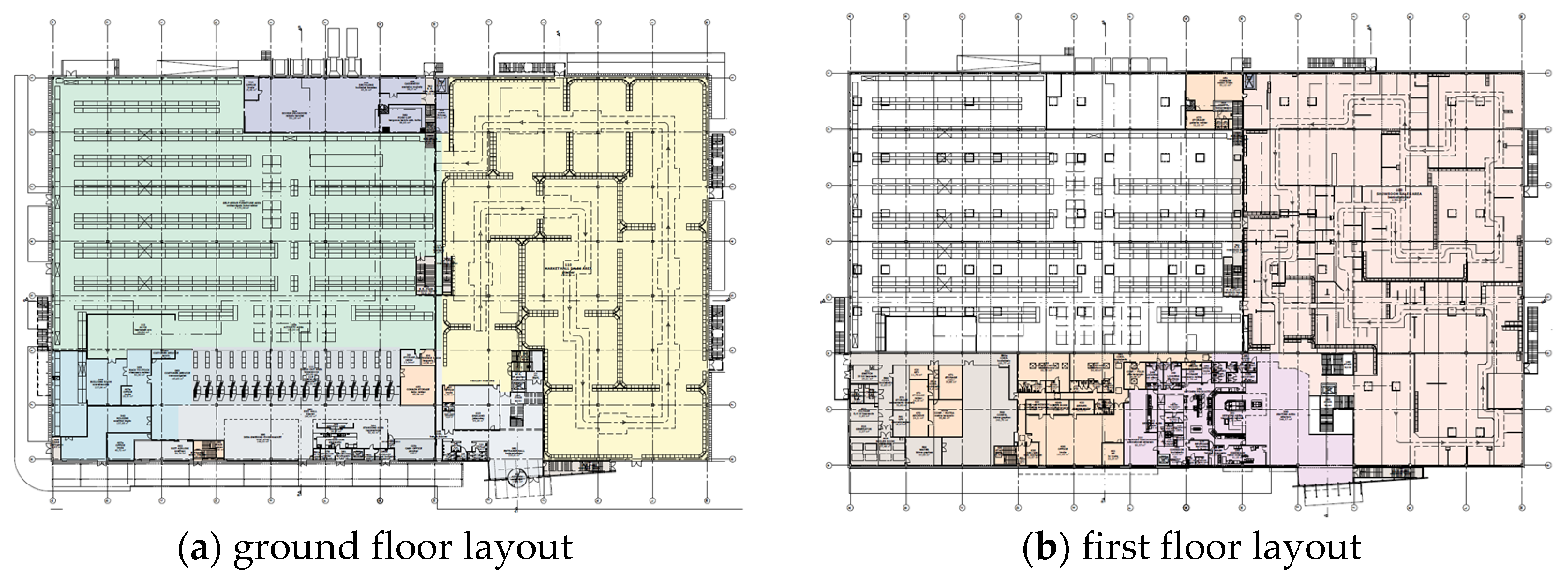


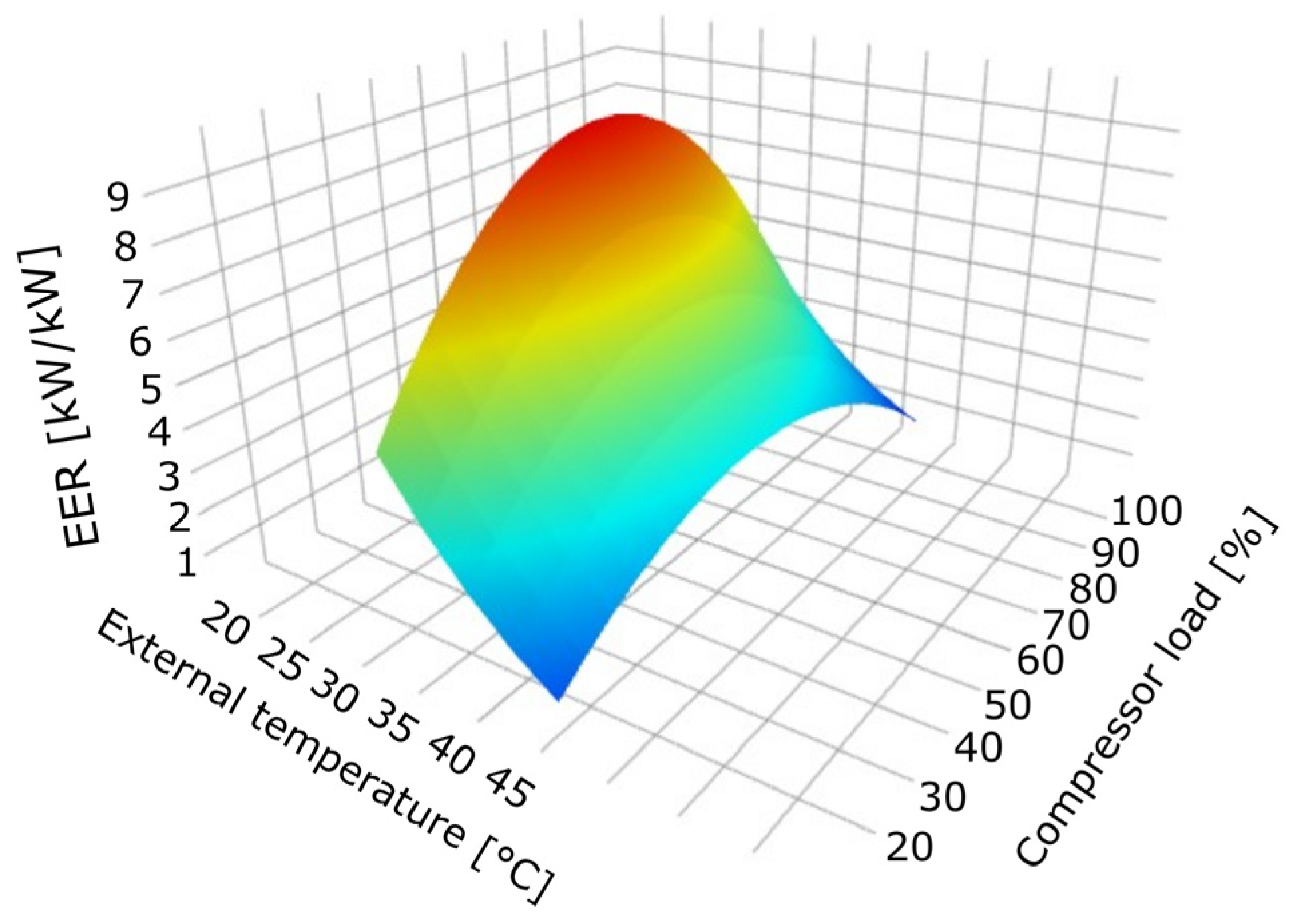
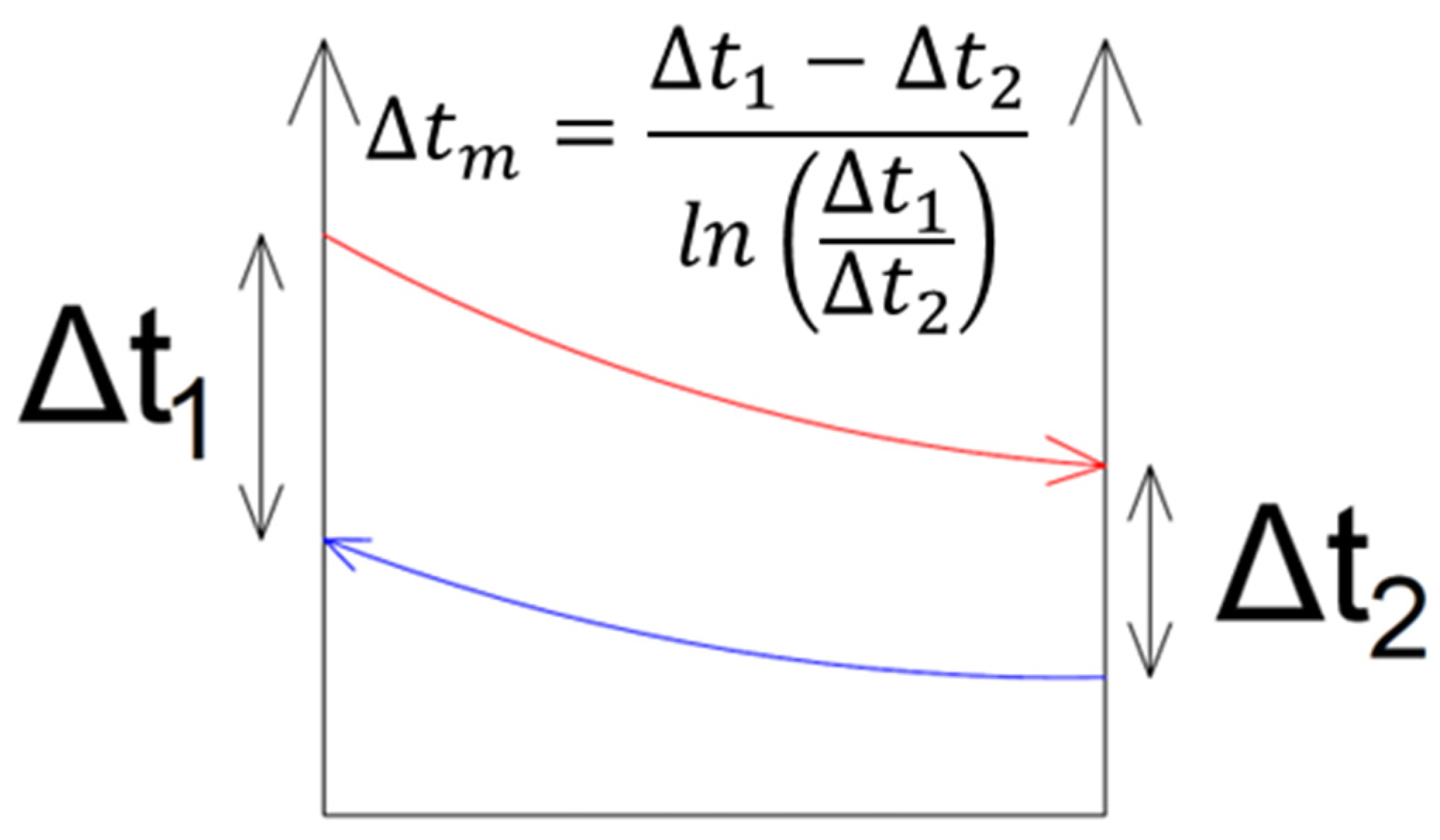

| Thermal transmittance values of external structures (U) | Facade | 0.3 Wm−2K−1 | ||||
| Roof | 0.3 Wm−2K−1 | |||||
| Floor | 0.45 Wm−2K−1 | |||||
| Windows | 2.4 Wm−2K−1 (g-value: 0.44) | |||||
| Roof windows | 1.15 Wm−2K−1 (g-value: 0.25) | |||||
| Store open hours: Monday–Saturday: 10.00–20.00 h Sunday: 10.00–19.00 h |  | |||||
| Lightings | Entrance | 3.7 Wm−2 | ||||
| Showroom | 6.9 Wm−2 | |||||
| Restaurant area | 3.6 Wm−2 | |||||
| Market hall | 6.6 Wm−2 | |||||
| Self-serve furniture area | 2.4 Wm−2 | |||||
| Check out area | 7.6 Wm−2 | |||||
| AHU group (aggregated values) | Working time | 3.00–23.00 h | ||||
| Number of main AHUs | 2 pc | |||||
| Air volume flow | 154.000 m3h−1 | |||||
| Heat recovery efficiency | 60% | |||||
| Air quality (max. CO2 value) | 1000 PPM | |||||
| Cooling performance of the heat exchangers | 718 kW (7/12 °C water) | |||||
| Compact water chiller | Type | YORK YCAM-B 700 | ||||
| Refrigerant | R407C | |||||
| 7/12 °C water | Outside temp. | 30 °C | 32 °C | 35 °C | 40 °C | 45 °C |
| Cooling perf. | 590 kW | 570 kW | 540 kW | 490 kW | 441 kW | |
| Electric perf. | 177 kW | 180 kW | 185 kW | 193 kW | 201 kW | |
| EER * | 3.33 | 3.16 | 2.92 | 2.54 | 2.19 | |
| Centrifugal water chiller | Type | YORK YMC2 S840AA | ||||
| Refrigerant | R134A | |||||
| Nominal cooling performance | 840 kW | |||||
| Water tank | Volume | 600 m3 | ||||
| Estimated heat loss ** | 260 WK−1 | |||||
| Typical Summer Day 6 June 2019 (cloudy day) | 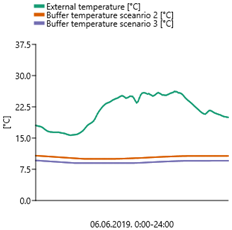 | Average external air temp.: 21.6 °C Max. external air temp.: 26.5 °C Min. external air temp.: 15.7 °C Max. mech. cooling demand: 289.8 kW Req. mech. cooling energy: 1708.0 kWh |
| Centrifugal Water Chiller without Cooling Water Tank (Scenario 1) | Centrifugal Water Chiller with Cooling Water Tank (Scenario 2) | Centrifugal Water Chiller with Cooling Water Tank (Scenario 3) |
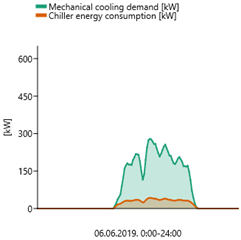 | 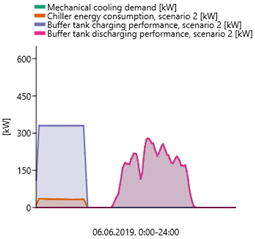 |  |
| Max. mech. c. demand: 289.8 kW Req. mech. c. energy: 1708.0 kWh Chiller en. consumption: 301.4 kWh dEER: 5.67 kW/kW | Max. mech. c. demand: 330.0 kW Buffer charging energy: 1925.0 kWh Buffer discharging e.: 1708.0 kWh Produced mech. c. energy: 1925.0 kWh Chiller en. consumption: 196.9 kWh | Max. mech. cooling demand: 330.0 kW Buffer charging energy: 1540.0 kWh Buffer discharging e.: 1296.0 kWh Produced mech. c. energy: 1952.0 kW Chiller en. consumption: 236.8 kWh |
| Typical Hot Day 5 July 2019 (clear sky day) |  | Average external air temp.: 25.1 °C Max. external air temp.: 31.8 °C Min. external air temp.: 16.6 °C Max. mech. cooling demand: 448.5 kW Req. mech. cooling energy: 3688.3 kWh |
| Centrifugal Water Chiller without Cooling Water Tank (Scenario 1) | Centrifugal Water Chiller with Cooling Water Tank (Scenario 2) | Centrifugal Water Chiller with Cooling Water Tank (Scenario 3) |
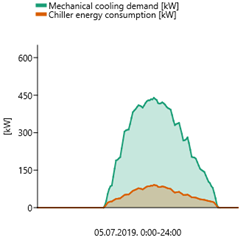 | 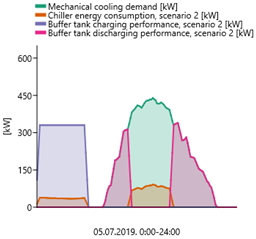 | 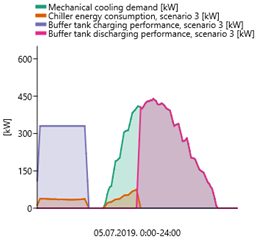 |
| Max. mech. c. demand: 448.5 kW Req. mech. c. energy: 3688.3 kWh Chiller en. consumption: 725.4 kWh dEER: 5.08 kW/kW | Max. mech. c. demand: 448.5 kW Buffer charging energy: 1925.0 kWh Buffer discharging e.: 1631.2 kWh Produced. mech. c. energy: 3556.3 kWh Chiller en. consumption: 609.7 kWh | Max. mech. cooling demand: 406.8 kW Buffer charging energy: 1925.0 kWh Buffer discharging e.: 2720.2 kWh Produced mech. c. energy: 2893.1 kW Chiller en. consumption: 391.9 kWh |
| Typical Torrid Day 12 August 2019 (clear sky day) |  | Average external air temp.: 29.9 °C Max. external air temp.: 37.8 °C Min. external air temp.: 21.2 °C Max. mech. cooling demand: 620.6 kW Req. mech. cooling energy: 5512.2 kWh |
| Centrifugal Water Chiller without Cooling Water Tank (Scenario 1) | Centrifugal Water Chiller with Cooling Water Tank (Scenario 2) | Centrifugal Water Chiller with Cooling Water Tank (Scenario 3) |
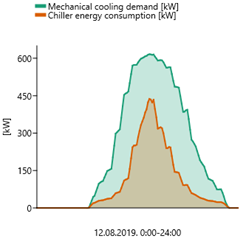 |  |  |
| Max. mech. c. demand: 620.6 kW Req. mech. c. energy: 5512.2 kWh Chiller en. consumption: 2246.4 kWh dEER: 2.45 kW/kW | Max. mech. c. demand: 620.6 kW Buffer charging energy: 1925.0 kWh Buffer discharging e.: 1491.0 kWh Produced mech. c. energy: 5946.2 kWh Chiller en. consumption: 2143.4 kWh | Max. mech. cooling demand: 620.6 kW Buffer charging energy: 1925.0 kWh Buffer discharging e.: 1513.2 kWh Produced mech. c. energy: 5924.0 kW Chiller en. consumption: 2113.9 kWh |
| Scenarios | Energy Consumption of Cooling (Chiller and Water Tank Pump) [kWh] | Operating Hours of Water Chiller [h] | SEER [kW/kW] |
|---|---|---|---|
| 1 | 77,209 [100%] | 1358 [100%] | 4.49 [100%] |
| 2 | 65,928 [85.4%] | 952 [70.1%] | 5.85 [130.3%] |
| 3 | 65,666 [85.0%] | 1171 [86.2%] | 5.72 [127.4%] |
Disclaimer/Publisher’s Note: The statements, opinions and data contained in all publications are solely those of the individual author(s) and contributor(s) and not of MDPI and/or the editor(s). MDPI and/or the editor(s) disclaim responsibility for any injury to people or property resulting from any ideas, methods, instructions or products referred to in the content. |
© 2022 by the authors. Licensee MDPI, Basel, Switzerland. This article is an open access article distributed under the terms and conditions of the Creative Commons Attribution (CC BY) license (https://creativecommons.org/licenses/by/4.0/).
Share and Cite
Kostyák, A.; Béres, C.; Szekeres, S.; Csáky, I. Buffer Tank Discharge Strategies in the Case of a Centrifugal Water Chiller. Energies 2023, 16, 188. https://doi.org/10.3390/en16010188
Kostyák A, Béres C, Szekeres S, Csáky I. Buffer Tank Discharge Strategies in the Case of a Centrifugal Water Chiller. Energies. 2023; 16(1):188. https://doi.org/10.3390/en16010188
Chicago/Turabian StyleKostyák, Attila, Csaba Béres, Szabolcs Szekeres, and Imre Csáky. 2023. "Buffer Tank Discharge Strategies in the Case of a Centrifugal Water Chiller" Energies 16, no. 1: 188. https://doi.org/10.3390/en16010188
APA StyleKostyák, A., Béres, C., Szekeres, S., & Csáky, I. (2023). Buffer Tank Discharge Strategies in the Case of a Centrifugal Water Chiller. Energies, 16(1), 188. https://doi.org/10.3390/en16010188









